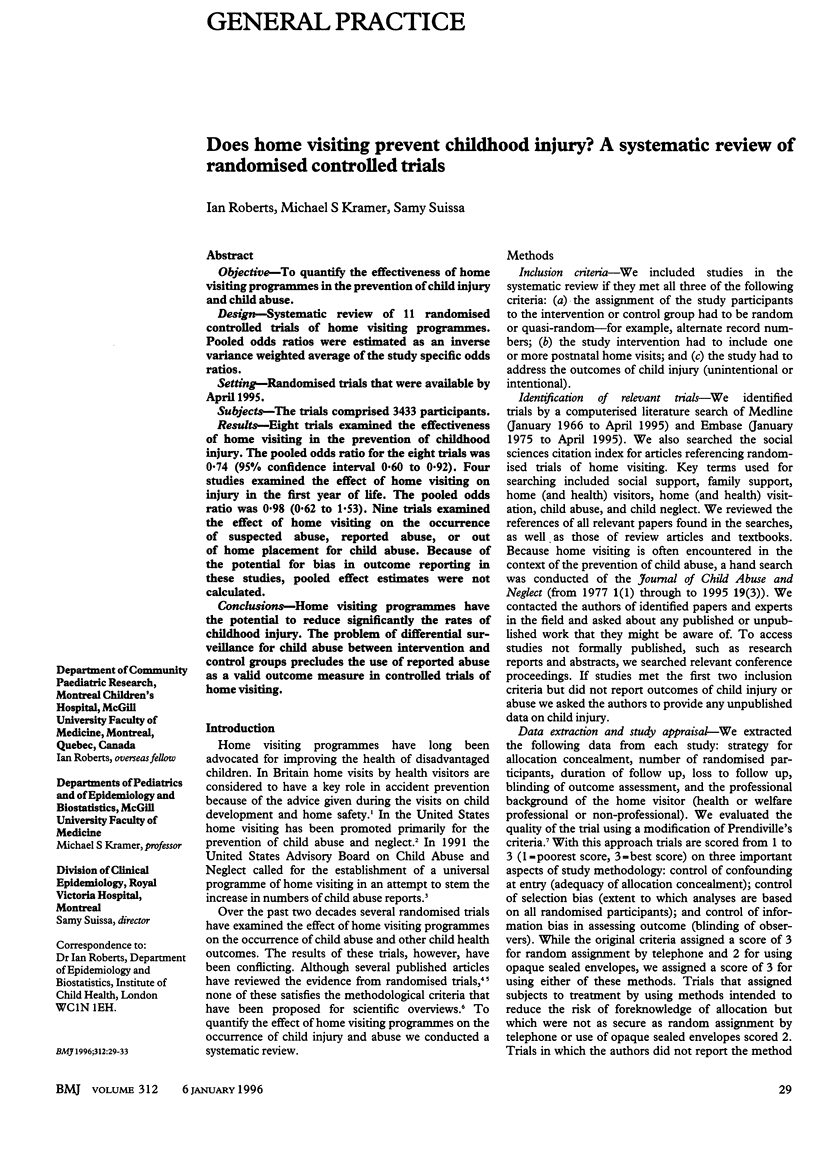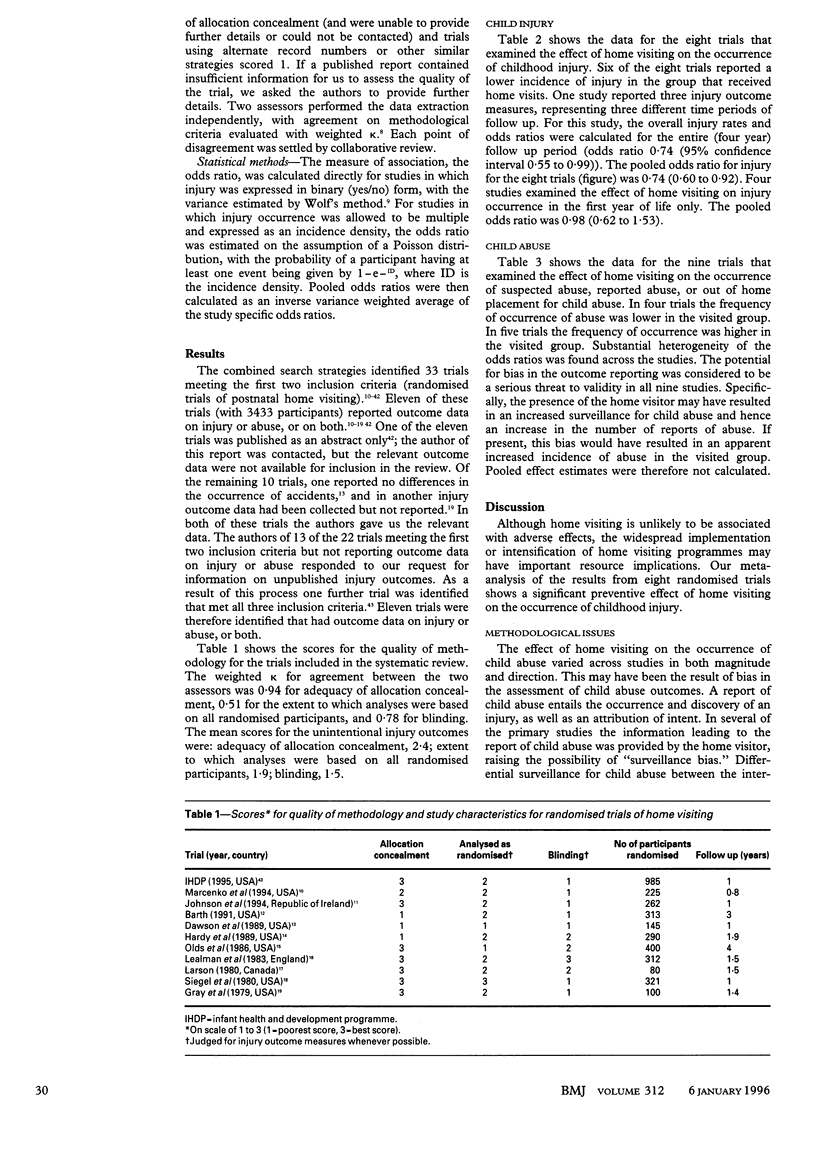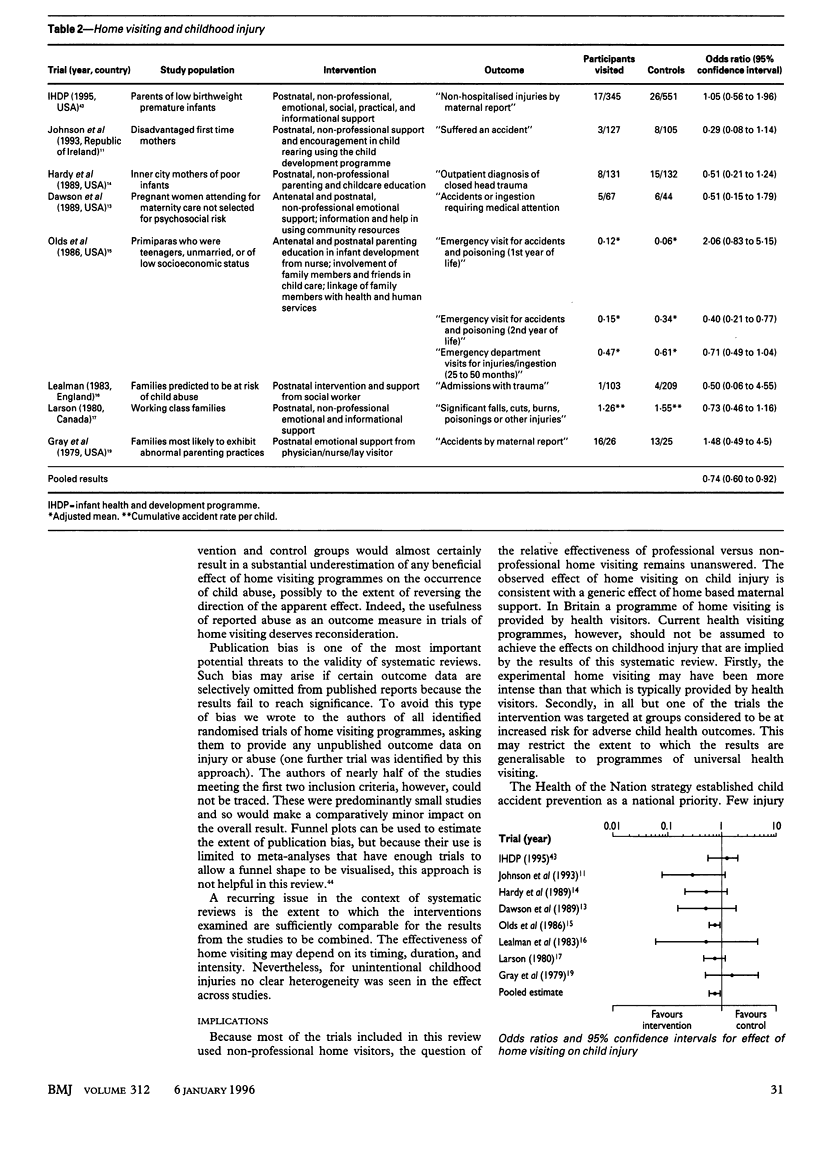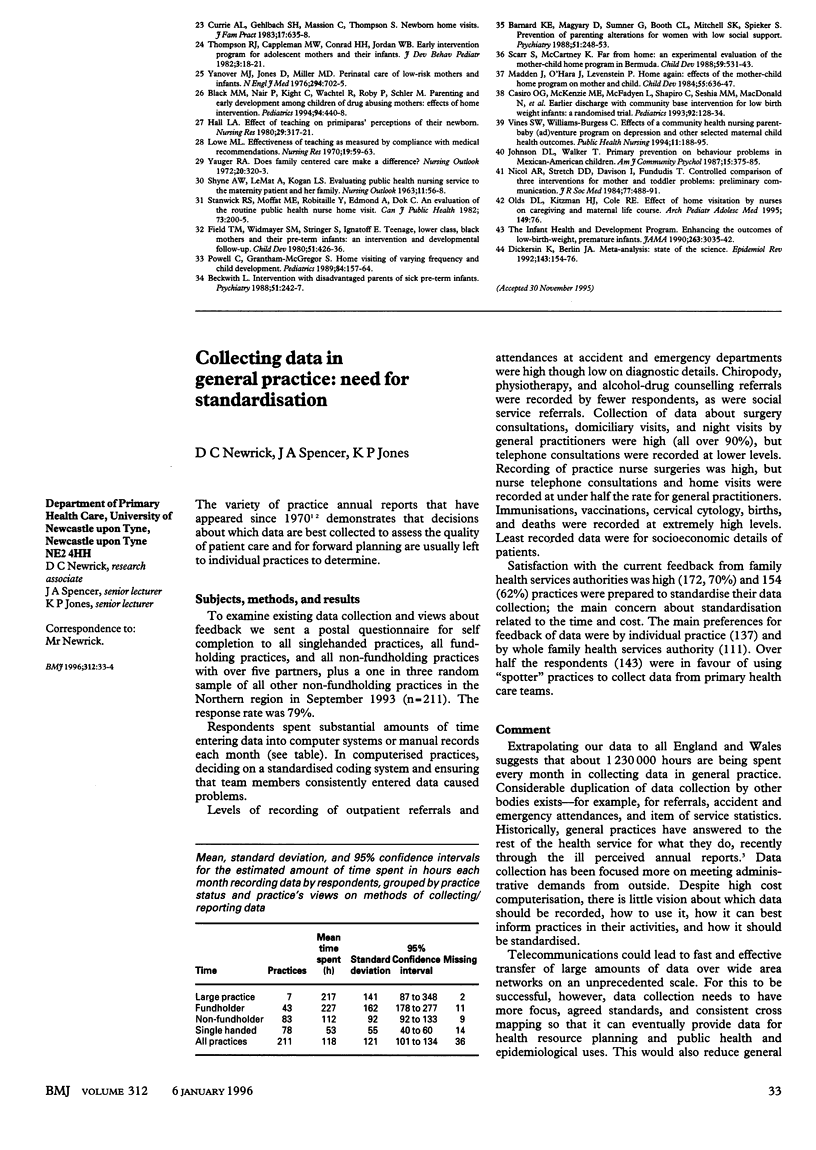Abstract
OBJECTIVE--To quantify the effectiveness of home visiting programmes in the prevention of child injury and child abuse. DESIGN--Systematic review of 11 randomised controlled trials of home visiting programmes. Pooled odds ratios were estimated as an inverse variance weighted average of the study specific odds ratios. SETTING--Randomised trials that were available by April 1995. SUBJECTS--The trials comprised 3433 participants. RESULTS--Eight trials examined the effectiveness of home visiting in the prevention of childhood injury. The pooled odds ratio for the eight trials was 0.74 (95% confidence interval 0.60 to 0.92). Four studies examined the effect of home visiting on injury in the first year of life. The pooled odds ratio was 0.98 (0.62 to 1.53). Nine trials examined the effect of home visiting on the occurrence of suspected abuse, reported abuse, or out of home placement for child abuse. Because of the potential for bias in outcome reporting in these studies, pooled effect estimates were not calculated. CONCLUSIONS--Home visiting programmes have the potential to reduce significantly the rates of childhood injury. The problem of differential surveillance for child abuse between intervention and control groups precludes the use of reported abuse as a valid outcome measure in controlled trials of home visiting.
Full text
PDF




Selected References
These references are in PubMed. This may not be the complete list of references from this article.
- Barnard K. E., Magyary D., Sumner G., Booth C. L., Mitchell S. K., Spieker S. Prevention of parenting alterations for women with low social support. Psychiatry. 1988 Aug;51(3):248–253. doi: 10.1080/00332747.1988.11024399. [DOI] [PubMed] [Google Scholar]
- Barth R. P. An experimental evaluation of in-home child abuse prevention services. Child Abuse Negl. 1991;15(4):363–375. doi: 10.1016/0145-2134(91)90021-5. [DOI] [PubMed] [Google Scholar]
- Beckwith L. Intervention with disadvantaged parents of sick preterm infants. Psychiatry. 1988 Aug;51(3):242–247. doi: 10.1080/00332747.1988.11024398. [DOI] [PubMed] [Google Scholar]
- Black M. M., Nair P., Kight C., Wachtel R., Roby P., Schuler M. Parenting and early development among children of drug-abusing women: effects of home intervention. Pediatrics. 1994 Oct;94(4 Pt 1):440–448. [PubMed] [Google Scholar]
- Casey P. H., Kelleher K. J., Bradley R. H., Kellogg K. W., Kirby R. S., Whiteside L. A multifaceted intervention for infants with failure to thrive. A prospective study. Arch Pediatr Adolesc Med. 1994 Oct;148(10):1071–1077. doi: 10.1001/archpedi.1994.02170100069014. [DOI] [PubMed] [Google Scholar]
- Casiro O. G., McKenzie M. E., McFadyen L., Shapiro C., Seshia M. M., MacDonald N., Moffatt M., Cheang M. S. Earlier discharge with community-based intervention for low birth weight infants: a randomized trial. Pediatrics. 1993 Jul;92(1):128–134. [PubMed] [Google Scholar]
- Combs-Orme T., Reis J., Ward L. D. Effectiveness of home visits by public health nurses in maternal and child health: an empirical review. Public Health Rep. 1985 Sep-Oct;100(5):490–499. [PMC free article] [PubMed] [Google Scholar]
- Currie A. L., Gehlbach S. H., Massion C., Thompson S. Newborn home visits. J Fam Pract. 1983 Oct;17(4):635–638. [PubMed] [Google Scholar]
- Dawson P., van Doorninck W. J., Robinson J. L. Effects of home-based, informal social support on child health. J Dev Behav Pediatr. 1989 Apr;10(2):63–67. [PubMed] [Google Scholar]
- Dickersin K., Berlin J. A. Meta-analysis: state-of-the-science. Epidemiol Rev. 1992;14:154–176. doi: 10.1093/oxfordjournals.epirev.a036084. [DOI] [PubMed] [Google Scholar]
- Field T. M., Widmayer S. M., Stringer S., Ignatoff E. Teenage, lower-class, black mothers and their preterm infants: an intervention and developmental follow-up. Child Dev. 1980 Jun;51(2):426–436. [PubMed] [Google Scholar]
- Greenberg R. A., Strecher V. J., Bauman K. E., Boat B. W., Fowler M. G., Keyes L. L., Denny F. W., Chapman R. S., Stedman H. C., LaVange L. M. Evaluation of a home-based intervention program to reduce infant passive smoking and lower respiratory illness. J Behav Med. 1994 Jun;17(3):273–290. doi: 10.1007/BF01857953. [DOI] [PubMed] [Google Scholar]
- Hall L. A. Effect of teaching on primiparas' perceptions of their newborn. Nurs Res. 1980 Sep-Oct;29(5):317–322. [PubMed] [Google Scholar]
- Hardy J. B., Streett R. Family support and parenting education in the home: an effective extension of clinic-based preventive health care services for poor children. J Pediatr. 1989 Dec;115(6):927–931. doi: 10.1016/s0022-3476(89)80744-9. [DOI] [PubMed] [Google Scholar]
- Johnson D. L., Walker T. Primary prevention of behavior problems in Mexican-American children. Am J Community Psychol. 1987 Aug;15(4):375–385. doi: 10.1007/BF00915208. [DOI] [PubMed] [Google Scholar]
- Johnson Z., Howell F., Molloy B. Community mothers' programme: randomised controlled trial of non-professional intervention in parenting. BMJ. 1993 May 29;306(6890):1449–1452. doi: 10.1136/bmj.306.6890.1449. [DOI] [PMC free article] [PubMed] [Google Scholar]
- Kempe C. H. Approaches to preventing child abuse. The health visitors concept. Am J Dis Child. 1976 Sep;130(9):941–947. doi: 10.1001/archpedi.1976.02120100031005. [DOI] [PubMed] [Google Scholar]
- Larson C. P. Efficacy of prenatal and postpartum home visits on child health and development. Pediatrics. 1980 Aug;66(2):191–197. [PubMed] [Google Scholar]
- Lealman G. T., Haigh D., Phillips J. M., Stone J., Ord-Smith C. Prediction and prevention of child abuse--an empty hope? Lancet. 1983 Jun 25;1(8339):1423–1424. doi: 10.1016/s0140-6736(83)92367-x. [DOI] [PubMed] [Google Scholar]
- Lowe M. L. Effectiveness of teaching as measured by compliance with medical recommendations. Nurs Res. 1970 Jan-Feb;19(1):59–63. [PubMed] [Google Scholar]
- Madden J., O'Hara J., Levenstein P. Home again: effects of the Mother-Child Home Program on mother and child. Child Dev. 1984 Apr;55(2):636–647. [PubMed] [Google Scholar]
- Marcenko M. O., Spence M. Home visitation services for at-risk pregnant and postpartum women: a randomized trial. Am J Orthopsychiatry. 1994 Jul;64(3):468–478. doi: 10.1037/h0079547. [DOI] [PubMed] [Google Scholar]
- Nicol A. R., Stretch D. D., Davison I., Fundudis T. Controlled comparison of three interventions for mother and toddler problems: preliminary communication. J R Soc Med. 1984 Jun;77(6):488–491. doi: 10.1177/014107688407700609. [DOI] [PMC free article] [PubMed] [Google Scholar]
- Olds D. L., Henderson C. R., Jr, Chamberlin R., Tatelbaum R. Preventing child abuse and neglect: a randomized trial of nurse home visitation. Pediatrics. 1986 Jul;78(1):65–78. [PubMed] [Google Scholar]
- Olds D. L., Kitzman H. Can home visitation improve the health of women and children at environmental risk? Pediatrics. 1990 Jul;86(1):108–116. [PubMed] [Google Scholar]
- Oxman A. D., Cook D. J., Guyatt G. H. Users' guides to the medical literature. VI. How to use an overview. Evidence-Based Medicine Working Group. JAMA. 1994 Nov 2;272(17):1367–1371. doi: 10.1001/jama.272.17.1367. [DOI] [PubMed] [Google Scholar]
- Powell C., Grantham-McGregor S. Home visiting of varying frequency and child development. Pediatrics. 1989 Jul;84(1):157–164. [PubMed] [Google Scholar]
- Prendiville W., Elbourne D., Chalmers I. The effects of routine oxytocic administration in the management of the third stage of labour: an overview of the evidence from controlled trials. Br J Obstet Gynaecol. 1988 Jan;95(1):3–16. doi: 10.1111/j.1471-0528.1988.tb06475.x. [DOI] [PubMed] [Google Scholar]
- SHYNE A. W., LEMAT A. F., KOGAN L. S. Evaluating public health nursing service to the maternity patient and her family. Nurs Outlook. 1963 Jan;11:56–58. [PubMed] [Google Scholar]
- Siegel E., Bauman K. E., Schaefer E. S., Saunders M. M., Ingram D. D. Hospital and home support during infancy: impact on maternal attachment, child abuse and neglect, and health care utilization. Pediatrics. 1980 Aug;66(2):183–190. [PubMed] [Google Scholar]
- Stanwick R. S., Moffat M. E., Robitaille Y., Edmond A., Dok C. An evaluation of the routine postnatal public health nurse home visit. Can J Public Health. 1982 May-Jun;73(3):200–205. [PubMed] [Google Scholar]
- Thompson R. J., Jr, Cappleman M. W., Conrad H. H., Jordan W. B. Early intervention program for adolescent mothers and their infants. J Dev Behav Pediatr. 1982 Mar;3(1):18–21. [PubMed] [Google Scholar]
- Vines S. W., Williams-Burgess C. Effects of a community health nursing parent-baby (ad)venture program on depression and other selected maternal-child health outcomes. Public Health Nurs. 1994 Jun;11(3):188–194. doi: 10.1111/j.1525-1446.1994.tb00400.x. [DOI] [PubMed] [Google Scholar]
- Yanover M. J., Jones D., Miller M. D. Perinatal care of low-risk mothers and infants. Early discharge with home care. N Engl J Med. 1976 Mar 25;294(13):702–705. doi: 10.1056/NEJM197603252941306. [DOI] [PubMed] [Google Scholar]
- Yauger R. A. Program evaluation in community health nursing: does family-centered care make a difference? Nurs Outlook. 1972 May;20(5):320–323. [PubMed] [Google Scholar]


